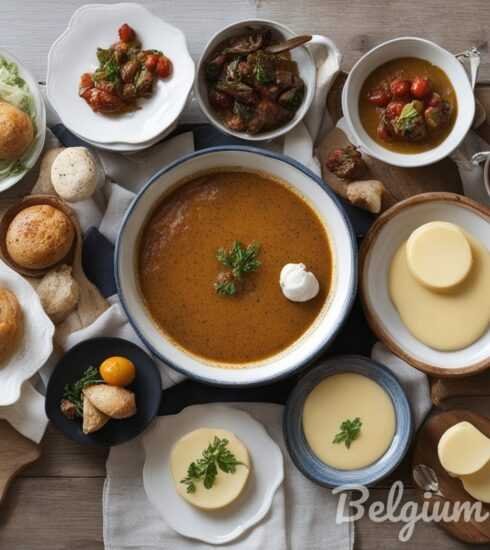Discover Belgian Village Cuisine: Unveiling Local Bites and Culinary Secrets
Local Bites: A Belgian Village’s Culinary Secrets Unveiled
When it comes to culinary delights, Belgium often conjures images of chocolates, waffles, and beer. However, this small European country packs a punch far beyond these popular treats, especially in its quaint villages where centuries-old recipes and unpretentious dining experiences await. Join us as we unveil the culinary secrets of a Belgian village, delving deep into its rich gastronomic tapestry.
As part of our exploration into Belgian cuisine, we recommend checking out two complementary articles on Belgian gastronomy and Belgian bites, which provide further insight into the nation’s diverse food culture. These articles can be found at Belgian Gastronomy and Belgium Bites.
The Heart of Belgian Village Cuisine
Belgium’s villages are repositories of culinary history, often preserving age-old recipes passed down through generations. Local farms, markets, and family-owned restaurants play pivotal roles in maintaining the authentic dining experience. Key ingredients here include fresh produce, regional cheeses, and artisan breads, which form the backbone of local dishes.
Staples of Belgian Village Fare
The culinary scene in Belgian villages is characterized by a few timeless staples:
- Flemish Stew (Carbonade Flamande): A hearty beef stew slow-cooked in beer, typically served with fries or bread.
- Waterzooi: A creamy, rich stew of fish or chicken, vegetables, and potatoes, often accompanied by bread.
- Endive and Ham Gratin: Belgian endives wrapped in ham and baked in cheese sauce.
- Moules-Frites: A quintessential Belgian dish of mussels cooked in white wine and vegetables, paired with crispy fries.

Unique Local Ingredients
Each Belgian village boasts a unique array of locally-sourced ingredients that define its culinary landscape. While the list is diverse, some of the standout ingredients include:
- Grey Shrimp: Often found in coastal villages, these small, sweet shrimps are used in a variety of dishes including Shrimp Croquettes and salads.
- White Asparagus: Known as “white gold,” these delicate stalks are featured in many springtime dishes and beloved by locals for their unique flavor profile.
- Farmhouse Cheeses: Every village seems to have its specialty cheese, ranging from Abbey cheeses to sharp blues and creamy bries.
Culinary Traditions and Festivals
Belgian villages take great pride in their culinary traditions, often celebrating local produce and dishes through festivals and feasts. Some notable events include:
- Beer Festivals: Celebrating Belgium’s long history of brewing, these events often feature village-specific brews.
- Harvest Festivals: Showcasing the season’s produce, these festivals bring together local farmers, chefs, and artisans.
- Feast of Saint Nicholas (Sinterklaas): A winter holiday with a rich array of traditional cookies, sweets, and special dishes.

Exploring Village Markets
To truly experience the local flavors, visiting village markets is a must. These markets offer an abundance of fresh produce, meats, cheeses, and baked goods. Among the stalls, you’ll find:
- Fresh Fruits and Vegetables: From the region’s famed white asparagus to juicy apples and berries, the freshness is unparalleled.
- Artisan Bread: Crispy on the outside, soft on the inside, these bread varieties are often made using traditional methods.
- Heirloom Cheeses: Often matured to perfection, these cheeses reflect the rich dairy farming heritage of Belgian villages.
Hidden Gems: Family-Owned Restaurants
Dotted throughout the Belgian countryside are family-owned restaurants that offer a cozy, intimate dining experience. Here, you can savor traditional dishes prepared following family recipes:
- La Petite Ferme: Known for its warm, rustic ambiance and dishes like rabbit stew and mashed potatoes infused with local herbs.
- Bistro du Village: Celebrates local seafood with dishes such as mussels in garlic cream sauce and seared scallops.
- Chez Thérèse: Offers a taste of homemade desserts, including blackcurrant tarts and custard-filled pastries.
The Role of Belgian Beer

No exploration of Belgian cuisine would be complete without mentioning beer. Belgian beers, with their diverse range of flavors, complement and enhance local dishes beautifully. Be sure to try:
- Trappist Beers: Brewed within Trappist monasteries, these beers are known for their rich, complex profiles.
- Saison Beers: Originally brewed in farmhouse breweries, these beers are perfect for lighter dishes or sipping on a warm day.
- Lambic Beers: Unique to Belgium, these sour beers offer a refreshing counterpoint to rich stews and meat dishes.
Experiencing Local Bites Through Culinary Tours
If you’re looking to immerse yourself in the culinary heartbeat of a Belgian village, consider joining a culinary tour. These tours often include:
- Guided Market Visits: Led by local chefs who provide insights into selecting the best produce and ingredients.
- Cookery Classes: Hands-on sessions where you can learn to prepare traditional dishes.
- Food and Beer Pairing Tours: Experience the art of pairing Belgian beers with local bites.
Conclusion: Embark on Your Culinary Adventure
The culinary secrets of a Belgian village are waiting to be discovered. Whether it’s savoring a hearty stew, enjoying fresh market produce, or sipping on a centuries-old beer recipe, the authentic experiences here are endless. Dive deep into the heart of Belgian gastronomy and uncover the treasures that have made this village cuisine so beloved. For more information and further culinary inspiration, don’t miss out on our detailed articles on Belgian Gastronomy and Belgium Bites.






